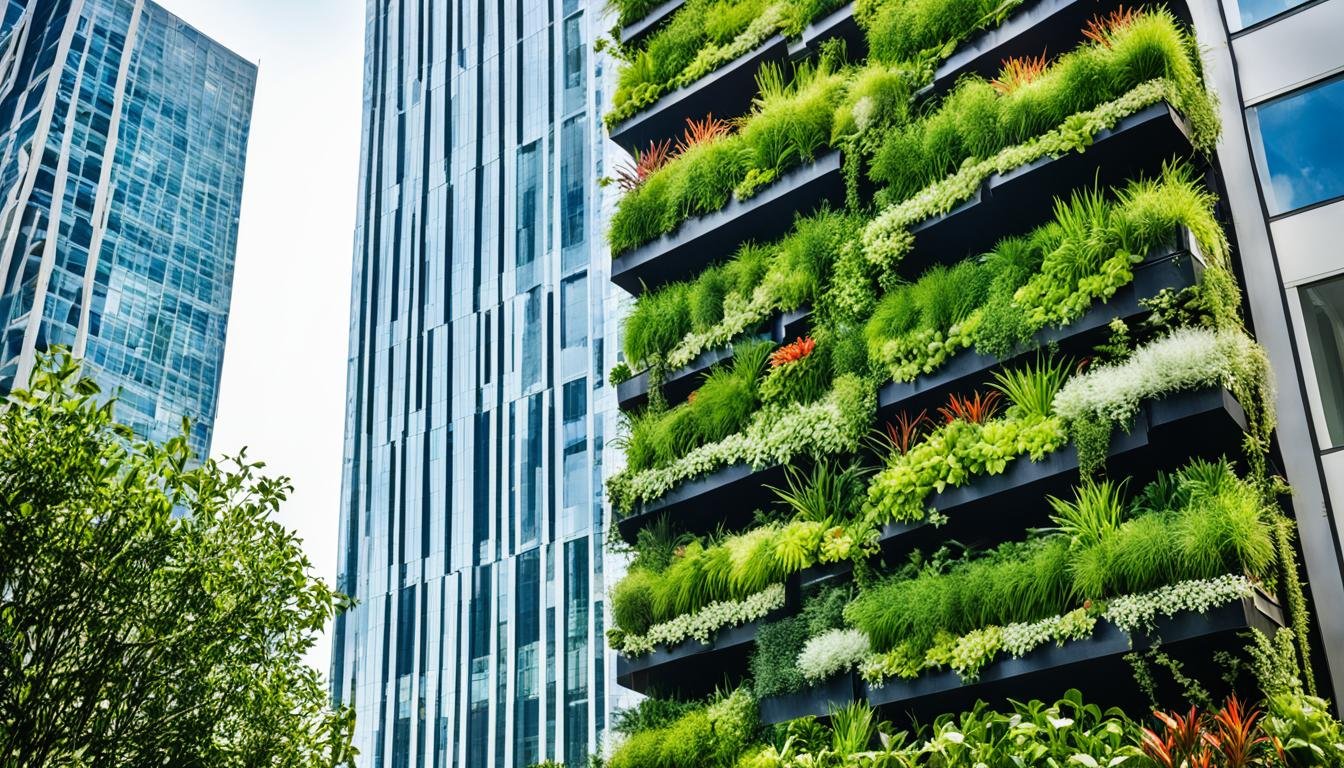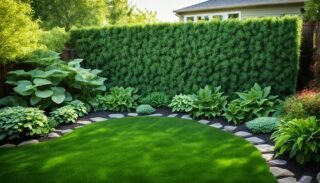Table of Contents
- What is Vertical Gardening?
- Choosing the Right Location for Your Vertical Garden
- Essential Tools and Materials for Vertical Gardening
- Selecting Plants for Your Vertical Garden
- Vertical Gardening Tips for Small Spaces
- DIY Vertical Garden Ideas
- Maintaining Your Vertical Garden
- Vertical Gardening for Urban Environments
- FAQ
- What is vertical gardening?
- What are the benefits of vertical gardening?
- What types of plants are suitable for vertical gardens?
- How do I choose the right location for my vertical garden?
- What materials do I need for a vertical garden?
- How do I water and maintain a vertical garden?
- Can I create a vertical garden indoors?
Ever wondered how to turn your cramped urban space into a lush oasis? Vertical gardening might just be the answer you’re looking for. This innovative approach to gardening has taken root in cities across the United States. It transforms bland walls into vibrant green canvases.
I’ve seen firsthand how vertical gardens can breathe life into unexpected places. From tiny balconies to stark office buildings, these living walls are redefining urban gardening. They’re not just pretty; they’re practical too, making the most of every inch of space.
As cities grow denser, the need for creative gardening solutions becomes more pressing. That’s where vertical gardening shines. It’s a game-changer for folks like me who love plants but don’t have a sprawling backyard. With the right tips and tricks, anyone can create a thriving vertical garden, no matter how limited their space might be.
Key Takeaways
- Vertical gardening maximizes space in urban environments
- Living walls improve air quality and aesthetics
- Space-saving gardening techniques suit various settings
- Green walls can thrive in both outdoor and indoor spaces
- Vertical gardens offer a solution for plant lovers with limited space
What is Vertical Gardening?
I’m thrilled to talk about vertical gardening, a new way to garden that’s changing the game. It uses space up high instead of out wide. It’s great for city folks or anyone with little outdoor space.
Definition and Concept
Vertical gardening means growing plants on walls, fences, or special structures. It lets me fill small areas with lots of plants. This method is perfect for those living in apartments, on balconies, or in tiny yards.
Benefits of Growing Vertically
There are many perks to vertical farming:
- Saves space in cities
- Improves air quality
- Reduces water use
- Creates natural insulation
- Provides a beautiful, living art piece
History and Evolution
Vertical gardening isn’t new. The Babylonians used it thousands of years ago with their hanging gardens. Now, it’s a key part of modern architecture and city planning.
With more people moving to cities and environmental issues, vertical gardening is key for growing food and living green. It’s a field that keeps getting better and more innovative.
Choosing the Right Location for Your Vertical Garden
Finding the perfect spot for a vertical garden is key to its success. I always think about sunlight, wind protection, and wall strength.
Sunlight is vital for plants to grow well. I look for spots that get at least 6 hours of direct sunlight a day. For plants that like shade, I choose areas with filtered light or morning sun. Indoor gardens do great near south-facing windows.
Wind protection is crucial, especially for outdoor gardens. I find sheltered spots or make windbreaks to protect my plants. This keeps them safe from damage and losing too much water.
It’s important to make sure the wall can hold the weight of the garden. I check the wall’s strength before setting up. For lighter gardens, I might use tension rods or freestanding setups.
- Assess sunlight patterns throughout the day
- Check for wind exposure and create barriers if needed
- Evaluate wall strength or consider alternative support systems
By thinking about these things, I make sure my vertical garden does well. The right spot is crucial for a green space that flourishes, whether inside or outside.
Essential Tools and Materials for Vertical Gardening
I’m excited to share the key tools and materials you’ll need for a thriving vertical garden. Let’s dive into the essentials that will set you up for success!
Support Structures
Trellises are my go-to for vertical support. They come in various styles and materials, perfect for climbing plants. For a DIY approach, I’ve used bamboo poles or repurposed ladders with great results.
Containers and Planters
Pocket planters are a game-changer for vertical gardening. They maximize space and look fantastic on walls. I also love using hanging baskets and tiered planters for a cascading effect.

Soil and Fertilizers
Lightweight, well-draining soil is crucial for vertical gardens. I mix potting soil with perlite or vermiculite for optimal results. Slow-release fertilizers keep my plants nourished without frequent applications.
Irrigation Systems
Proper watering is key to vertical garden success. I’ve found drip irrigation systems to be incredibly efficient. For small setups, self-watering planters work wonders. Hydroponic systems are another excellent option, especially for indoor vertical gardens.
With these tools and materials, you’re ready to create a stunning vertical garden. Remember, the key is to choose what works best for your space and plant choices!
Selecting Plants for Your Vertical Garden
I love choosing plants for my vertical garden! It’s like picking the perfect outfit for my green space. I look at their growth habits, light needs, and how they’ll look. This makes sure my garden is both thriving and beautiful.
https://www.youtube.com/watch?v=Mb2FQaQ1iLk
Climbing plants are perfect for vertical gardens. They grow up naturally, fitting well on trellises and walls. Favorites of mine include jasmine, clematis, and morning glories. These plants add height and drama to any area.
Trailing plants are also great. They flow down, creating a lush look. I often use ivy, pothos, and string of pearls. They’re ideal for hanging baskets or top-tier planters in a vertical garden.
- Succulents: Perfect for sunny spots and low maintenance
- Herbs: Great for kitchen gardens and add wonderful scents
- Ferns: Ideal for shady areas and add texture
Succulents are great for sunny spots and are easy to care for. They come in interesting shapes and colors. I also like using herbs like basil, thyme, and mint. They look good and are useful in the kitchen.
It’s important to pair plants with similar needs. This makes caring for them easier and helps them all do well together in their space.
Vertical Gardening Tips for Small Spaces
Living in a small apartment doesn’t mean you can’t garden. I’ve found some great ways to save space for gardening. These methods can turn even the smallest areas into green spaces.
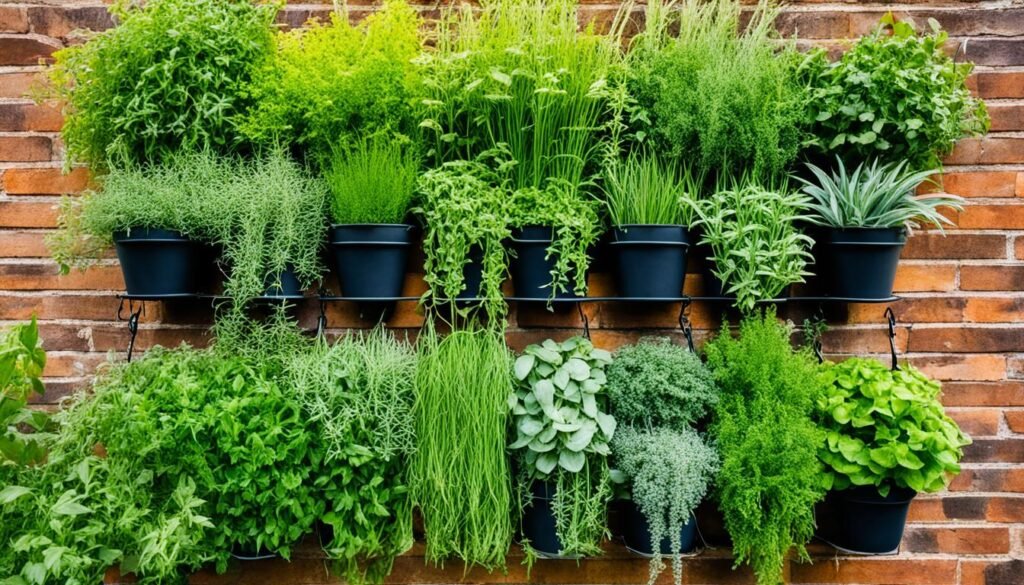
Balcony Gardens
My balcony garden shows how powerful vertical gardening can be. I use tiered planters and hanging baskets to use every inch of space. Plants like peas and beans climb up trellises, and strawberries grow from wall pockets.
Indoor Vertical Gardens
Inside, I’ve made a beautiful living wall with a pocket planter system. It’s ideal for herbs and small greens. I also turned an old bookshelf into a vertical garden, filling each shelf with plants.
Window Box Vertical Gardens
Window boxes are now great for growing herbs too. I’ve made mine into vertical gardens. Trellises on the back let climbing herbs like thyme grow up. Meanwhile, basil and parsley fill the base.
These ideas have changed how I garden in my apartment. With creativity and the right techniques, anyone can have a garden, even in a small space.
DIY Vertical Garden Ideas
I love getting creative with my gardening projects, and vertical gardens offer endless possibilities. Let’s explore some fun DIY ideas that can transform your space into a green oasis.
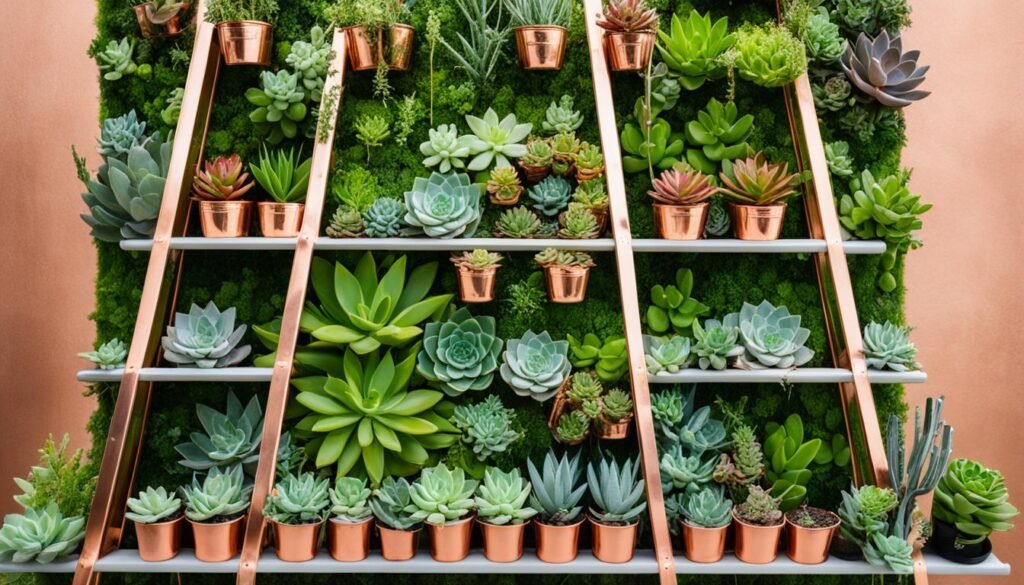
Upcycled planters are a great way to start. I’ve turned old wooden crates, tin cans, and even worn-out shoes into unique plant holders. It’s amazing how a coat of paint and some drainage holes can breathe new life into everyday items.
Pallet gardens are another favorite of mine. Here’s a simple guide to create your own:
- Find a sturdy wooden pallet
- Sand rough edges and apply a weather-resistant sealant
- Staple landscape fabric to the back and bottom
- Fill with potting soil
- Plant your chosen flowers or herbs
Hanging bottle gardens are perfect for small spaces. I’ve repurposed plastic bottles by cutting them in half, drilling drainage holes, and suspending them with sturdy rope. These make charming homes for trailing plants like ivy or strawberries.
Remember, the key to successful DIY vertical gardens is proper drainage and secure mounting. With a little creativity, you can turn any vertical space into a thriving garden oasis.
Maintaining Your Vertical Garden
Keeping your green wall healthy is all about good maintenance. Let’s look at some key tips for plant care in your vertical garden.
Watering Techniques
Watering your vertical garden needs some care. I use a drip system for even moisture. For smaller gardens, I water from the top, letting excess water flow down. This helps prevent too much water and keeps plants healthy.
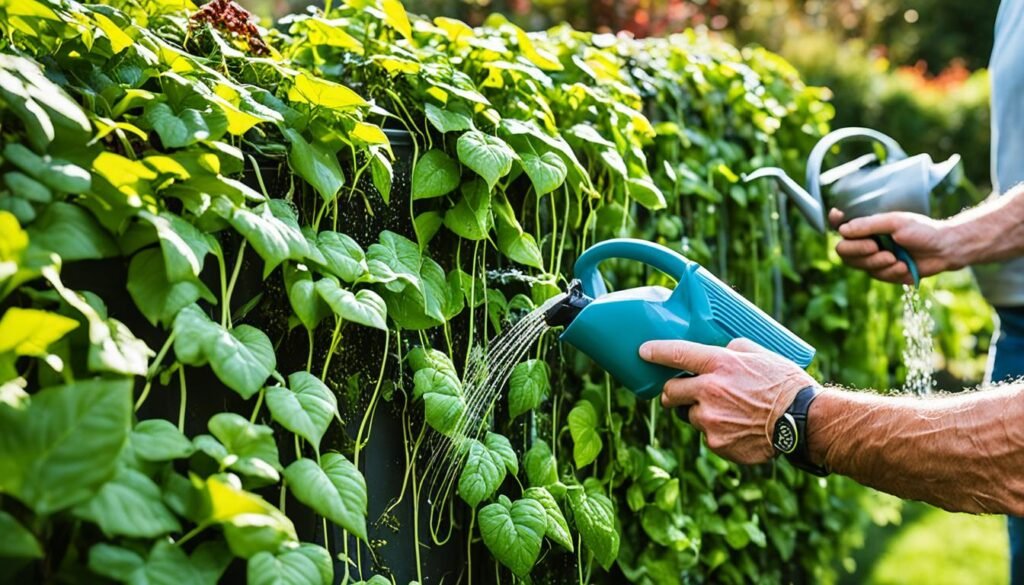
Pruning and Training Plants
Pruning is a must for vertical gardens. I cut back overgrown plants to keep them neat and promote fuller growth. Training vines on supports makes them look lush. I use soft ties to guide them without hurting the stems.
Pest Control in Vertical Gardens
For pests, I prefer organic methods. I check my plants often for pests. Neem oil spray is great for keeping pests away. If pests are tough, I bring in ladybugs. They eat the bad bugs without using harmful chemicals.
- Inspect plants weekly for pest signs
- Use neem oil for general pest prevention
- Introduce beneficial insects for natural control
By following these tips, my vertical gardens stay full of life and free of pests. Remember, regular care is the key to a beautiful vertical garden!
Vertical Gardening for Urban Environments
I’ve seen how vertical gardening turns city walls into green havens. It’s incredible how it brings life to our urban spaces. In cities where land is limited, growing upwards is a smart choice.
Green buildings are becoming more common, and it’s for a good reason. Vertical gardens on buildings clean the air and cut down on energy bills. They work like natural air conditioners, keeping buildings cool in summer and warm in winter.
Rooftop gardens are another smart use of city space. These gardens offer fresh produce, homes for wildlife, and help with stormwater. They also give city folks a place to relax and enjoy nature.
By adopting vertical gardening, we can make our cities better places to live. It’s not just about looking good – it’s about making our cities sustainable and improving our lives. Every bit of greenery on walls or balconies makes our cities healthier and happier.

